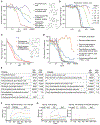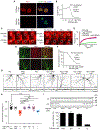Rescue of Transgenic Alzheimer's Pathophysiology by Polymeric Cellular Prion Protein Antagonists
- PMID: 30605671
- PMCID: PMC6358723
- DOI: 10.1016/j.celrep.2018.12.021
Rescue of Transgenic Alzheimer's Pathophysiology by Polymeric Cellular Prion Protein Antagonists
Erratum in
-
Rescue of Transgenic Alzheimer's Pathophysiology by Polymeric Cellular Prion Protein Antagonists.Cell Rep. 2019 Jan 29;26(5):1368. doi: 10.1016/j.celrep.2019.01.064. Cell Rep. 2019. PMID: 30699361 Free PMC article. No abstract available.
Abstract
Cellular prion protein (PrPC) binds the scrapie conformation of PrP (PrPSc) and oligomeric β-amyloid peptide (Aβo) to mediate transmissible spongiform encephalopathy (TSE) and Alzheimer's disease (AD), respectively. We conducted cellular and biochemical screens for compounds blocking PrPC interaction with Aβo. A polymeric degradant of an antibiotic targets Aβo binding sites on PrPC with low nanomolar affinity and prevents Aβo-induced pathophysiology. We then identified a range of negatively charged polymers with specific PrPC affinity in the low to sub-nanomolar range, from both biological (melanin) and synthetic (poly [4-styrenesulfonic acid-co-maleic acid], PSCMA) origin. Association of PSCMA with PrPC prevents Aβo/PrPC-hydrogel formation, blocks Aβo binding to neurons, and abrogates PrPSc production by ScN2a cells. We show that oral PSCMA yields effective brain concentrations and rescues APPswe/PS1ΔE9 transgenic mice from AD-related synapse loss and memory deficits. Thus, an orally active PrPC-directed polymeric agent provides a potential therapeutic approach to address neurodegeneration in AD and TSE.
Keywords: Alzheimer; Alzheimer’s disease; amyloid-beta; antagonist; hydrogel; memory; oligomer; prion; scrapie; synapse loss; β-amyloid.
Copyright © 2018 The Author(s). Published by Elsevier Inc. All rights reserved.
Conflict of interest statement
DECLARATION OF INTERESTS
S.M.S. and E.C.G. are inventors on patents disclosing PrP-C antagonism for treatment of Alzheimer’s disease. G.M. is a full-time employee of ReNetX Bio, Inc.
Figures







References
-
- Aimi T, Suzuki K, Hoshino T, and Mizushima T (2015). Dextran sulfate sodium inhibits amyloid-β oligomer binding to cellular prion protein. J. Neurochem 134, 611–617. - PubMed
-
- Baertschi SW, Dorman DE, Occolowitz JL, Collins MW, Spangle LA, Stephenson GA, and Lorenz LJ (1997). Isolation and structure elucidation of the major degradation products of cefaclor formed under aqueous acidic conditions. J. Pharm. Sci 86, 526–539. - PubMed
Publication types
MeSH terms
Substances
Grants and funding
LinkOut - more resources
Full Text Sources
Other Literature Sources
Medical
Molecular Biology Databases
Research Materials

